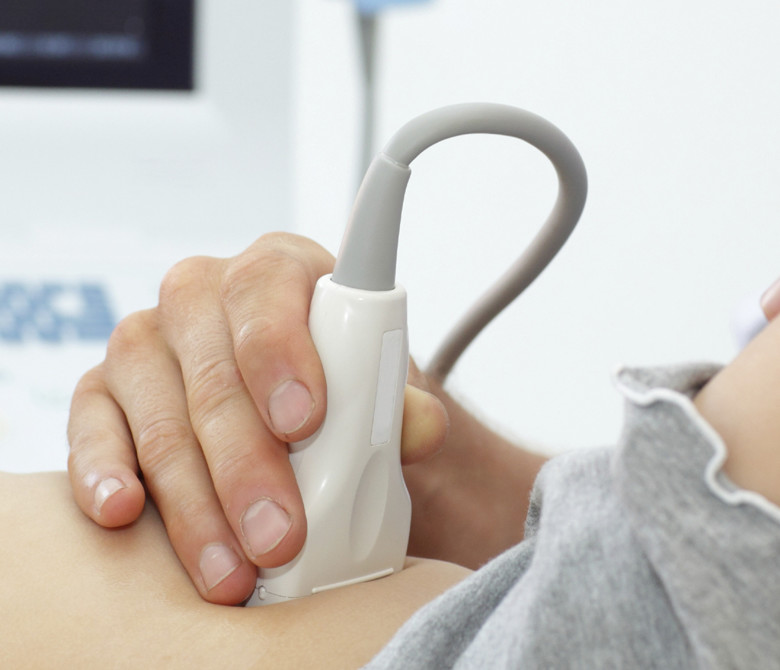Ultrasound

Ultrasound is safe and painless test which produces pictures of the inside of the body using sound waves. Ultrasound imaging, also called ultrasound scanning and sonography, involves the use of a small hand held transducer (probe) and ultrasound gel placed directly on the skin. High-frequency sound waves are transmitted from the probe through the gel into the body. The transducer collects the sounds that bounce back and a computer then uses those sound waves to create an image. Ultrasound examinations do not use any form of radiation (as used in x-rays), so there is no radiation exposure. Because ultrasound images are captured in real-time, they can show the structure and movement of the body’s internal organs, as well as blood flowing through blood vessels.
Ultrasound imaging is a noninvasive medical test that helps physicians diagnose and treat medical conditions.
A Doppler ultrasound study may be part of an ultrasound examination.
Doppler ultrasound is a special ultrasound technique that allows the physician to see and evaluate blood flow through arteries and veins in the abdomen, arms, legs, neck and/or brain (in infants and children) or within various body organs such as the liver or kidneys.
There are three types of Doppler ultrasound:
- Color Doppler uses a computer to convert Doppler measurements into many colors to show the speed and direction of blood flow through a blood vessel.
- Power Doppler is a newer technique that is more sensitive than color Doppler and can provide greater detail of blood flow, especially when blood flow is little or minimal.
- Spectral Doppler displays blood flow measurements graphically, in terms of the distance traveled per unit of time, rather than as a color picture. It can also convert blood flow information into sound that can be heard with every heartbeat.
What are some common uses of the procedure?
Ultrasound examinations can help to diagnose a variety of conditions and to assess organ damage following illness.
Ultrasound is used to help physicians evaluate symptoms such as:
- pain
- infection
- swelling
Ultrasound is a useful way of examining many of the body’s internal organs including but not limited to the:
- uterus
- breasts
- ovaries
- bladder
- kidneys
- spleen
- scrotum (testicles)
- pancreas
- gallbladder
- fetus in pregnant women
- heart and blood vessels, including abdominal aorta and its major branches
Ultrasound is also used to:
- guide procedures such as needle biopsies in which needles are used to sample cells from an abnormal area for laboratory analysis.
- image guided biopsy of the breast for breast cancer.
- diagnose many heart conditions, including valve problems and congestive heart failure, and to assess damage after a heart attack. Ultrasound of the heart is also called an “echocardiogram” or “echo”.
Doppler ultrasound images can help the physician to see and evaluate:
- narrowing of vessels
- blockages to blood flow (such as blood clots)
- tumors and congenital vascular malformations
- abnormal blood flow due to infection
Doppler studies can also help the physician determine if any additional medical testing or procedure is necessary.
How should I prepare?
Comfortable loose fitting clothing should be worn for your ultrasound exam. You may be asked to remove all clothing and jewelry in the area to be examined. It may be necessary for you to wear a gown.
Preparation for the procedure varies depending on the type of examination you will have. For some of the testing you may need to drink water or you may need to be fasting. The office will instruct you on the preparation for your procedure when you schedule your appointment.
How does the procedure work?
Ultrasound imaging uses the same principles involved in the sonar used by boats, ships and submarines. When a sound wave strikes an object, it echoes or bounces back. By measuring these echo waves, it is possible to determine how far away the object is as well as the object’s size, shape and whether it is fluid filled or solid. Ultrasound is also used to detect changes in appearance, size or contour of organs, tissues, and vessels or detect abnormal masses, such as tumors.
During the ultrasound examination a transducer sends the sound waves and receives the echoing waves. When the transducer is pressed against the skin, it sends small pulses of silent, high-frequency sound waves into the body. As the sound waves bounce off internal organs, fluids and tissues, the transducer’s sensitive microphone records tiny changes in the sound’s pitch and direction. These waves are instantly measured and displayed by a computer, which in turn creates a real-time picture on the monitor. One or more frames of the moving pictures are typically captured as still images. Moving real-time images can also be saved.
Doppler ultrasound is a special application of ultrasound, measures the direction and speed of blood cells as they move through vessels. The movement of blood cells causes a change in pitch of the reflected sound waves (called the Doppler effect). A computer processes the sounds and creates graphs or color pictures that represent the flow of blood through the blood vessels.
How is the procedure performed?
For most ultrasound exams, you will be asked to lay face-up on an examination table that can be tilted or moved. You may be asked to turn to either side or on occasion placed in a face down position to improve the quality of the images.
After you are positioned, the sonographer or radiologist will apply a warm water-based gel to the area of the body being studied. The gel will help the transducer make secure contact with the body to allow the sound waves to pass through the area being examined. The transducer is moved back and forth over the area being examined until the desired images are captured.
There is usually no discomfort from pressure as the transducer is pressed against the area being examined, however, if scanning is performed over a tender area you may feel pressure or minor pain from the transducer.
Once the exam is complete the clear ultrasound gel will be wiped off your skin.
In some ultrasound studies the transducer is attached to a probe and inserted into a natural opening in the body. These exams include:
- Transvaginal ultrasound – The transducer is inserted into a woman’s vagina to view the uterus and ovaries.
- Transrectal ultrasound – The transducer is inserted into a man’s rectum to view the prostate.
- Transesophageal echocardiogram – The transducer is inserted into the esophagus to obtain images of the heart.
What will I experience during and after the ultrasound?
Ultrasound examinations are painless and easily tolerated by most patients.
Ultrasound exams in which the transducer is inserted into an opening of the body may produce minimal discomfort.
If a Doppler ultrasound study is performed, you may actually hear pulse-like sounds that change in pitch as the blood flow is monitored and measured.
Most ultrasound examinations are completed within 20-30 minutes, although more extensive exams may take up to an hour.
When the examination is complete, you may be asked to wait while the ultrasound images are reviewed.
You should be able to resume your normal activities immediately after your ultrasound.
Who interprets the results and how am I informed?
A radiologist, a physician specifically trained to supervise and interpret radiology examinations, will analyze the images and send an electronic/fax report to your physician that ordered the test.
Your physician will convey the results to you and let you know if you need a follow-up exam and when it should be scheduled.
What are the benefits vs. risks?
Benefits
- Most ultrasound scanning is noninvasive (no needles or injections).
- On occasion, ultrasound exam may be temporarily uncomfortable but it is almost never painful.
- Ultrasound is easy-to-use and less expensive than other imaging methods.
- Ultrasound imaging is extremely safe and does not use any radiation.
- Ultrasound scanning gives a clear picture of soft tissues that may not show up well on x-ray images.
- Ultrasound is the preferred for the diagnosis and monitoring of pregnant women and their unborn babies.
- Ultrasound provides real-time imaging, making it a good tool for guiding minimally invasive procedures.
Risks
- For standard ultrasound there are no known harmful effects on humans.
What are the limitations of ultrasound?
Ultrasound waves are disrupted by air or gas; therefore ultrasound is not an ideal imaging technique for air-filled bowel or organs obscured by the bowel. In most cases, barium exams are done using CT scanning or MRI.
Large patients are more difficult to image by ultrasound because there is a greater amount of tissue which will weaken the sound waves as they pass deeper into the body.
Ultrasound can only see the outer surface of bony structures and not what lies within (except in infants who have more cartilage in their skeletons than older children or adults). For visualizing internal structure of bones or certain joints, other imaging such a MRI is typically used.
Please visit www.Radiologyinfo.org for additional information on this procedure.

